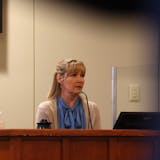A $30 million technology levy that Anoka-Hennepin voters approved last year is helping teachers and students master an elemental facet of learning: listening.
The first $3 million allocation from the 10-year levy went to purchase about 675 audio enhancement systems, designed to better distribute teachers' and students' voices around the classroom.
Most of the units were installed in elementary classrooms since younger children, who still are learning to listen, struggle more than older students with shutting out ambient noise, said Joel VerDuin, the district's new chief technology and information officer.
Others were installed in middle schools and high school science labs, which often are larger rooms with more activity and noise.
Each classroom is outfitted with two microphones. One hangs on a lanyard around the teacher's neck. Another can be passed among students so their voices can be heard during classroom discussions.
An amplifier gathers the sound and distributes it to a speaker array, mounted on the ceiling to distribute the sound evenly.
The levy was approved in November by Anoka-Hennepin voters at a cost of about $2.58 a month for the district's average home.
Elsewhere in the metro area, Edina and Orono are implementing new or renewed technology levies. And this November, Osseo will ask voters to approve $5 million per year for 10 years to improve access to computers and mobile devices and replace classroom equipment. The district also hopes to update its technology infrastructure.



